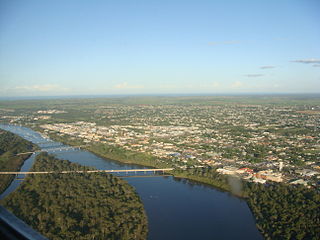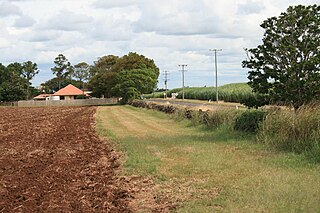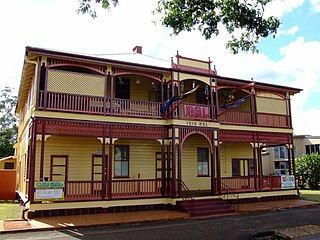
Bundaberg is a city in the Bundaberg Region, Queensland, Australia, and is the tenth largest city in the state. Bundaberg's regional area has a population of 70,921, and is a major centre of the Wide Bay–Burnett geographical region. The Bundaberg central business district is situated along the southern bank of the Burnett River, about 20 km (12 mi) from its mouth at Burnett Heads, and flows into the Coral Sea. The city is sited on a rich coastal plain, supporting one of the nation's most productive agricultural regions. The area of Bundaberg is the home of the Taribelang-Bunda peoples. Popular nicknames for Bundaberg include "Bundy" and "Rum city". The demonym of Bundaberg is Bundabergian.
CSR Limited is a major Australian industrial company, producing building products and having a 25% share in the Tomago aluminium smelter located near Newcastle, New South Wales. It is publicly traded on the Australian Securities Exchange. In 2021, it had over 3,000 employees and reported an after-tax profit of $146 million. The company has a diversified shareholding with predominantly Australian fund managers and retail owners. The group's corporate headquarters is in North Ryde, Sydney.

Golden syrup or light treacle is a thick, amber-coloured form of inverted sugar syrup made by the process of refining sugar cane or sugar beet juice into sugar, or by treatment of a sugar solution with acid. It is used in a variety of baking recipes and desserts. It has an appearance and consistency similar to honey, and is often used as a substitute where honey is unavailable or prohibitively expensive.
The Colonial Sugar Refining Company (CSR) began operations in Fiji in 1880 and until it ceased operations in 1973, had a considerable influence on the political and economic life of Fiji. Prior to its expansion to Fiji, the CSR was operating Sugar Refineries in Melbourne and Auckland. The decision to enter into the production of raw sugar and sugar cane plantation was due to the Company's desire to shield itself from fluctuations in the price of raw sugar needed to run its refining operations. In May 1880 Fiji's Colonial Secretary John Bates Thurston persuaded the Colonial Sugar Refining Company to extend their operations into Fiji by making available 2,000 acres (8 km²) of land to establish plantations.

Walkers Limited was an Australian engineering company, based in Maryborough, Queensland. It built ships and railway locomotives. The Walkers factory still produces railway locomotives and rolling stock as part of Downer Rail.
Sugar cane grew wild in Fiji and was used as thatch by the Fijians for their houses (bures). The first attempt to make sugar in Fiji was on Wakaya Island in 1862 but this was a financial failure. With the cotton boom of the 1860s there was little incentive to plant a crop that required high capital outlay but after a slump in cotton prices in 1870, the planters turned to sugar. In an effort to promote the production of sugar in Fiji, the Cakobau Government, in December 1871, offered a 500-pound reward for the first and best crop of twenty of sugar from canes planted before January 1873.

John Joseph Eastick is noted for being the first chemist at the sugar refinery Abram Lyle and Sons and patenting special methods for making brewers’ saccharum, inverted sugar syrup and golden syrup.
Charles Esau Eastick was a British chemist, noted for formulating golden syrup and patenting special methods for making brewers' saccharum and inverted sugar.

CSR Refinery is a heritage-listed former refinery at Lamington Street, New Farm, City of Brisbane, Queensland, Australia. It was built from 1892 to 1893. It is also known as Colonial Sugar Refining Company Refinery of New Farm. It was added to the Queensland Heritage Register on 21 October 1992.

Central Sugar Mill Ruins is a heritage-listed former sugar cane mill at Old Mill Road, Yengarie, Fraser Coast Region, Queensland, Australia. It was built from 1866 to 1890s. It was added to the Queensland Heritage Register on 5 December 2005.

Yengarie Sugar Refinery is a heritage-listed refinery at Old Mill Road, Yengarie, Fraser Coast Region, Queensland, Australia. It was built from c. 1867 to c. 1883. It was added to the Queensland Heritage Register on 21 October 1992.

Bourbong Street Weeping Figs is a heritage-listed group of trees at Bourbong Street, Bundaberg Central, Bundaberg, Bundaberg Region, Queensland, Australia. They were added to the Queensland Heritage Register on 23 July 1999.

Sir Anthony's Rest is a heritage-listed dry-stone lookout at Sir Anthony's Rest Street, Qunaba, Bundaberg Region, Queensland, Australia. It was built for the official visit of the Governor of Queensland, Sir Anthony Musgrave, to Bundaberg in his 1888 tour of the area. It is located on the summit of the Bundaberg Hummock hill and provides a commanding view of the surrounding Bargara canefields.

Sunnyside Sugar Plantation is the heritage-listed remains of a former sugar plantation at 94 Windermere Road, Windermere, Bundaberg Region, Queensland, Australia. It was built in c. 1880s by South Sea Islander labour. It is also known as Dry-rubble Boundary Wall. It was added to the Queensland Heritage Register on 13 May 1996.

Queensland National Bank is a heritage-listed former bank building at 50 Churchill Street, Childers, Bundaberg Region, Queensland, Australia. It was designed by Philip Oliver Ellard Hawkes and built in 1919. It is also known as Childers Travel World, Wrench & Cobb, and Ye Olde Boutique. It was added to the Queensland Heritage Register on 21 October 1992.

Childers RSL Club is a heritage-listed former bank and now Returned and Services League of Australia club house at 55 Churchill Street, Childers, Bundaberg Region, Queensland, Australia. It was designed by James Percy Owen Cowlishaw and built from 1900 to c. 1909. It was formerly a branch of the Commercial Banking Company of Sydney and is also known as the RSSAILA Club or the Isis RSL Club. It was added to the Queensland Heritage Register on 21 October 1992.

Jeffery's Building is a heritage-listed retail shop at 66–70 Churchill Street, Childers, Bundaberg Region, Queensland, Australia. It was designed by F H Faircloth and built in 1902. It is also known as Childers Medical Centre, Foodland, and R & D Meats and DJG Fruit & Vegetable shop. It was added to the Queensland Heritage Register on 21 October 1992.

Richmond Mill Ruins is a heritage-listed sugar cane mill at Habana Road, Richmond, Mackay, Mackay Region, Queensland, Australia. It was built in 1881. It is also known as Richmond Mill. It was added to the Queensland Heritage Register on 4 June 1996.

Fairymead Sugar Plantation was a sugar plantation in Fairymead, Bundaberg Region, Queensland, Australia. It was established by Ernest Young together with his father Henry and brothers Arthur, and Horace. It was one of Bundaberg's earliest independent sugar plantations and had one of its earliest sugar mills.















